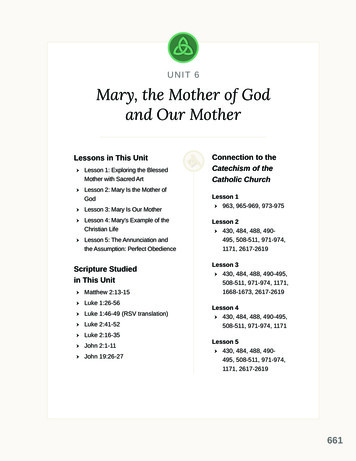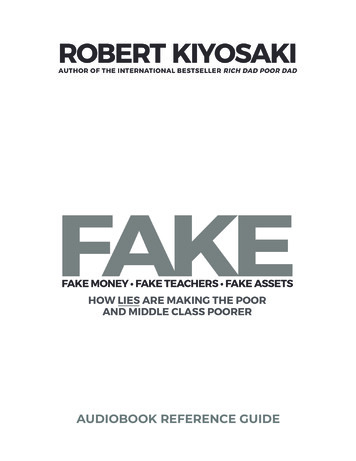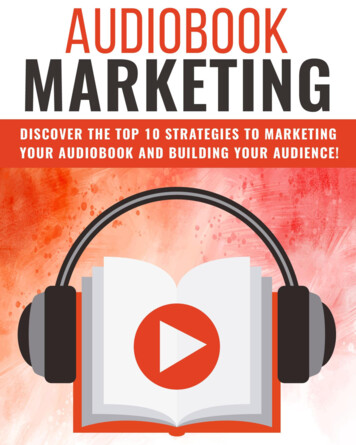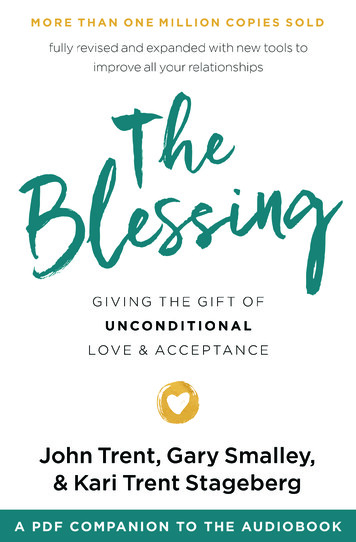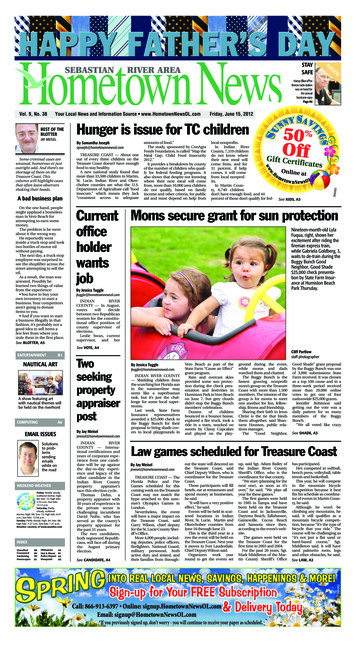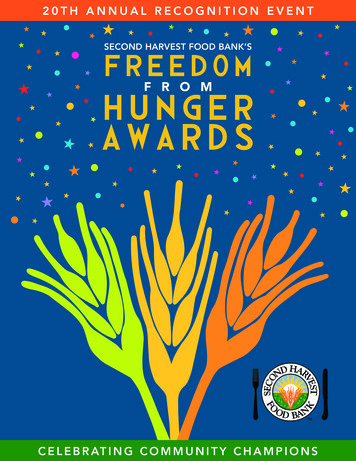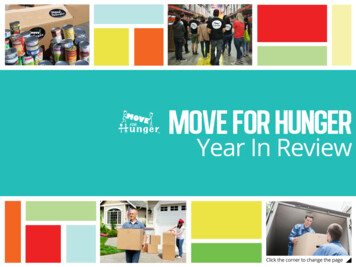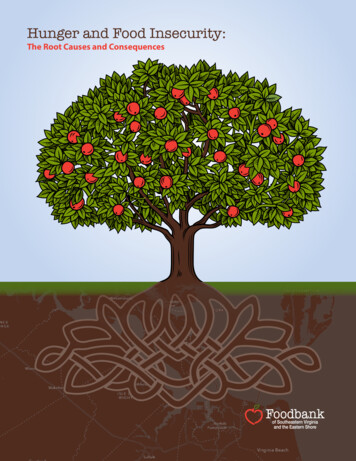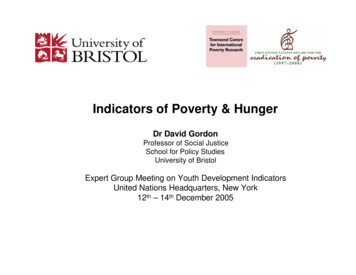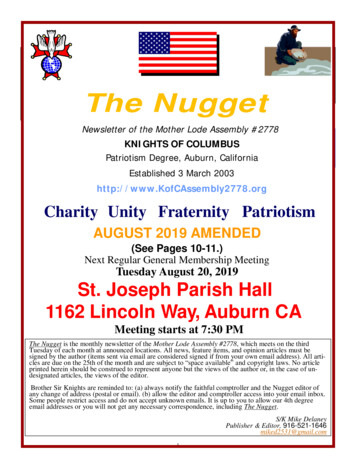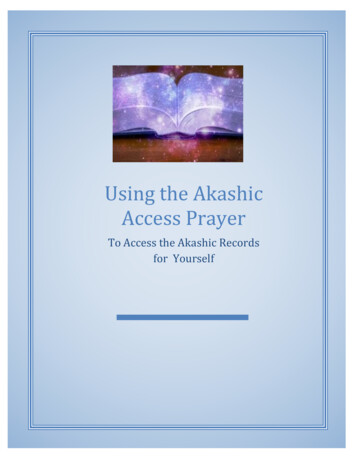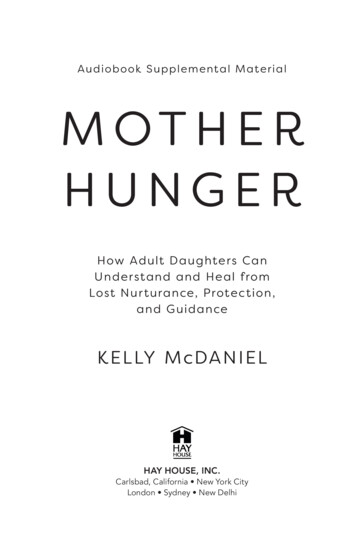
Transcription
Audiob o ok Supplement al Mat erialM OT H E RHUNGERHow Adult D aught ers CanUnderst and and He al fromLost Nur turance, Prot e c tion,and G uidanceK EL LY M cDA N I ELHAY HOUSE, INC.Carlsbad, California New York CityLondon Sydney New Delhi
M OT H E R H U N G E R AUDIOBOOK SUPPLEMENTAL MATERIALHunger QuestionnaireAs a child, were you encouraged to eat when youweren’t hungry? Were you forced to eat food that was disgusting to you?As a child, were you deprived of food when you werehungry? Were favorite foods withheld from you?How were mealtimes in your family? Who cooked? Didyou eat together or alone?As a child or adolescent, did you ever sneak food?Binge? Restrict?How do you know when you’re hungry? What sensationsemerge?2
M OT H E R H U N G E R AUDIOBOOK SUPPLEMENTAL MATERIALWhat is your favorite food? Why?Use three words to describe how you feel about food. Use three words to describe how you feel about sexualintimacy. Now, look at the words you listed for food and for sexualintimacy. Are they the same? Are they different? Why?Copyright 2017 Kelly McDaniel Therapy3
M OT H E R H U N G E R AUDIOBOOK SUPPLEMENTAL MATERIALFinding Guidance What is good about being a woman? What is difficult about being a woman? When did another woman stand up for me?How did it feel? When did I last stand up for or supportanother woman? What are women really like? Did you admire your mother? Did your mother have friendships with otherwomen? Were they happy relationships? What did you learn about sex from your motherand other caregivers? Is there a woman you admire, who you can trust,in your life?Based on the answers to the questions above, you canidentify where you need guidance. Guidance requires arole model. Who in your life seems to have solved the issueyou’re facing? How does she treat her friends? Do otherwomen like her?When you find a role model, spend time with thiswoman. If she is someone on TV or in a movie, imagine whatshe might do. Replacing maternal guidance is your chance tochoose women you admire and learn from them.4
M OT H E R H U N G E R AUDIOBOOK SUPPLEMENTAL MATERIALReclaiming Damaged Dreams and GoalsThis is a fun and fruitful way to identify your desires anddreams. To start, let’s prime your brain.Think of four of your significant achievements to date.What are you most proud of accomplishing? (For example,abstaining from alcohol or completing an academic programor moving to a new town are all significant achievements.) What are four ways you express creativity? (Planningmeals, entertaining friends and family, or creating music andart are just a few ideas.) What gives your life meaning? List four things that getyou out of bed in the morning. (Try to think of things thatmake you smile, like your pet, yoga class, or cup of coffee.) 5
M OT H E R H U N G E R AUDIOBOOK SUPPLEMENTAL MATERIALNow your brain is ready for the next part.Think of seven words to describe yourself, such asfunny, pretty, resilient, creative. (This is the “self” that feelsmost like you, not the “self” that worries about what othersthink.) Think of seven things that you like to do and that giveyou a sense of purpose and meaning. (Go back to the firstthree lists if you need ideas.) 6
M OT H E R H U N G E R AUDIOBOOK SUPPLEMENTAL MATERIALWhen you have all fourteen, pick your top threedescriptive words. (For example, words to describe yourself might include strong, pretty, persistent, funny, quiet, andintelligent. But now you pick your favorite three, such as (1)funny, (2) persistent, (3) pretty.) Now pick your favorite three activities. (For example,(1) reading, (2) cooking, (3) knitting.) Now it’s time for the finale: let’s operationalize whatyou have put together. Taking your top three from each category, make a sentence. (For example, I am funny, persistent,and pretty so that I can read, cook, and knit.)When you have your sentence, think of this as yourinternal compass for life. This can provide guidance for yourchoices and decisions.How much of your day-to-day reflects this statement? 10percent? 30 percent? 60 percent?What can you do to increase the percentage?The more your life reflects who you really are, the less youneed to fill the emptiness with unhealthy behaviors or people.7
M OT H E R H U N G E R AUDIOBOOK SUPPLEMENTAL MATERIALADDITIONALR ES O U RCESMany women earn security with help from a therapist.Some build an inner sense of security with the support ofgood friends, partners, and even pets. Depending on theseverity of your Mother Hunger, the ingredients for enhancing your attachment style will vary. You might be interestedin an online version of the Experiences in Close Relationships Scale to take a closer look at your attachment style(openpsychometrics.org/tests/ecr.php).The ACEs study shows a common denominator in eachmeasure of adversity: a lack of protection. Children withouta protective caregiver suffer more than children who haveone. Dr. Robert Block, former president of the AmericanAcademy of Pediatrics, is often quoted as saying, “ACEs arethe single greatest unaddressed public health threat facingour nation today.” Growing awareness of ACEs and theirconsequences reveal how much children need the protective presence of a consistent caregiver. Research shows thatif a trusted adult soothes a child during adversity, the impactof distress is less damaging, and the event may not becomean ACE. One pediatrician is taking this very seriously: Dr.Nadine Burke Harris, the first surgeon general of Californiaand author of The Deepest Well, is connecting the dotsbetween childhood illnesses and toxic stress and makingchanges to medical procedures that could further traumatize vulnerable children.12 In her widely viewed TED talk,8
M OT H E R H U N G E R AUDIOBOOK SUPPLEMENTAL MATERIALDr. Burke Harris says, “The single most important thing thatwe need today is the courage to look this problem in theface and say, this is real.”13 Childhood trauma isn’t something you just get over as you grow up. (For more information about ACEs, see “ACEs Science 101” and “Got Your ACEScore?” at ACEsConnection.com.)Finding a place to belong sounds much easier than itis. You have probably tried. Groups of women can be scaryplaces. You might have learned that churches aren’t safeeither. For this reason, I love 12-step programs. They are free,nonjudgmental places to belong. If the idea terrifies you, trya phone meeting or an online group like InTheRooms orSeeking Integrity (www.seekingintegrity.com) for support.Out of the Storm (www.outofthestorm.website) is ahelpful resource for finding a trauma-informed therapist.9
M OT H E R H U N G E R AUDIOBOOK SUPPLEMENTAL MATERIALENDNOTESIntroduction1. Lisa Donovan, Our Lady of Perpetual Hunger: A Memoir (New York:Penguin Press, 2020), 83.Chapter 11. Erica Komisar, Being There: Why Prioritizing Motherhood in the FirstThree Years Matters (New York: TarcherPerigee, 2017), 36.2. Marcy Axness, Parenting for Peace: Raising the Next Generation of Peacemakers (Boulder, CO: Sentient, 2012), 192.3. Gabor Maté, In the Realm of Hungry Ghosts: Close Encounters with Addiction (Berkeley, CA: North Atlantic Books, 2010), 436, as cited inAxness, Parenting for Peace, 193.4. Axness, Parenting for Peace, 194.5. Komisar, Being There, 36.6. Amir Levine and Rachel Heller, Attached: The New Science of Adult Attachment and How It Can Help You Find—And Keep—Love (New York:TarcherPerigree, 2010).7. Maia Szalavitz and Bruce D. Perry, Born for Love: Why Empathy Is Essential—and Endangered (New York: William Morrow, 2011), 20.8. Gwen Dewar, “Newborn Cognitive Development: What Do BabiesKnow, and How Do They Learn?,” Parenting Science, accessedDecember 2, 2020, development.html.9. Daniel J. Siegel and Tina Payne Bryson, The Whole-Brain Child: 12Revolutionary Strategies to Nurture Your Child’s Developing Mind (NewYork: Bantam, 2012).10
M OT H E R H U N G E R AUDIOBOOK SUPPLEMENTAL MATERIAL10. Maureen M. Black et al., “Early Childhood Development Comingof Age: Science Through the Life Course,” Lancet 389, no. 10064(2017): 77–90.11. Erin P. Hambrick et al., “Beyond the ACE Score: Examining Relationships Between Timing of Developmental Adversity, RelationalHealth and Developmental Outcomes in Children,” Archives ofPsychiatric Nursing 33, no. 3 (2019): 238–247.12. Allan Schore, “The American Bowlby: An Interview with AllanSchore,” telephone interview by Roz Carroll in March 2001.13. Centers for Disease Control and Prevention, “Essentials for Childhood:Creating Safe, Stable, Nurturing Relationships and Environments forAll Children,” accessed November 18, 2020, als-for-childhood-framework508.pdf.14. Megan H. Bair-Merritt et al., “A Framework for Thriving: A Comprehensive Approach to Child Health—CHCS Blog,” Center for Health CareStrategies, October 13, 2020, prehensive-approach-to-child-health.15. Komisar, Being There, 207.16. Jhoanna Robledo, “Developmental Milestone: Separation and Independence,” BabyCenter, December 12, 2018, evelopmental-milestone-separation-andindependence 6577.17. Harvard University Center on the Developing Child, “ACEs andToxic Stress: Frequently Asked Questions,” accessed September 20,2020, -andtoxic-stress-frequently-asked-questions; Adrienne Rich, “It Is Hardto Write About My Own Mother: On the Deep Complexity of theMother–Daughter Relationship,” Literary Hub, August 24, o-write-about-my-ownmother.18. Rich, “It is Hard to Write About My Own Mother.”19. Ibid.20. Adrienne Rich, Of Woman Born: Motherhood as Experience andInstitution (New York: W. W. Norton, 1986), 237.21. Resmaa Menakem, My Grandmother’s Hands: Racialized Trauma andthe Pathway to Mending Our Hearts and Bodies (Las Vegas: CentralRecovery Press, 2017), 42.22. Donald Woods Winnicott, Playing and Reality (London: Tavistock,1971).11
M OT H E R H U N G E R AUDIOBOOK SUPPLEMENTAL MATERIAL23. Marco Iacoboni, “The Mirror Neuron Revolution: Explaining WhatMakes Humans Social,” interview by Jonah Lehrer, ScientificAmerican, July 1, 2008, ror-neuron-revolut.24. “Why Former U.S. Surgeon General Vivek Murthy Believes Loneliness Is a ‘Profound’ Public Health Issue,” Washington Post Livevideo, 5:46, May 15, 2018, 11e89889-07bcc1327f4b video.html.Chapter 21. Daniel J. Siegel, “The Verdict Is In: The Case for AttachmentTheory,” Psychotherapy Networker, March/April 2011, ticle/343/the-verdict-is-in.2. Daniel J. Siegel, The Developing Mind: How Relationships and the BrainInteract to Shape Who We Are, 2nd ed. (New York: Guilford, 2012), 91.3. Psychology Hub, “Bowlby’s Theory of Maternal Deprivation:Romanian Orphan Studies—Effects of Institutionalization,”March 16, 2017, institutionalisation.4. Kendra Cherry, “Biography of Psychologist John Bowlby: The Founder of Attachment Theory,” Verywell Mind, March 29, 2020, -1907-1990-2795514.5. Allan N. Schore, “Attachment and the Regulation of the Right Brain,”Attachment & Human Development 2, no. 1 (2000): 23–47.6. Allan N. Schore, “The Experience-Dependent Maturation of a Regulatory System in the Orbital Prefrontal Cortex and the Origin ofDevelopmental Psychopathology,” Development and Psychopathology8, no. 1 (Winter 1996): 59–87.7. Peter Graf and Daniel L. Schacter, “Selective Effects of Interferenceon Implicit and Explicit Memory for New Associations,” Journal ofExperimental Psychology: Learning, Memory, and Cognition 13, no. 1(1987): 45–53.8. Brigid Schulte, “Effects of Child Abuse Can Last a Lifetime: Watchthe ‘Still Face’ Experiment to See Why,” Washington Post (blog),September 16, 2013, y.12
M OT H E R H U N G E R AUDIOBOOK SUPPLEMENTAL MATERIAL9. Schore, “Attachment and the Regulation of the Right Brain.”10. “Mother–Infant Communication: The Research of Dr. Beatrice BeebePromo,” produced by Karen Dougherty, YouTube video, 1:03, June23, 2016, https://www.youtube.com/watch?v rEMge2FeREw.11. Levine and Heller, Attached.12. Daniel P. Brown and David S. Elliott, Attachment Disturbances inAdults: Treatment for Comprehensive Repair (New York: W. W. Norton,2016).13. Jean Baker Miller, “Connections, Disconnections, and Violations,”Work in Progress 33 (Wellesley, MA: Stone Center Working PaperSeries, 1988): 5.14. Sarah Peyton, “Are You Suffering from Alarmed Aloneness?,” interview by Om Times podcast, July 12, 2019, suffering-from-alarmed-aloneness.Chapter 31. South Africa Mail & Guardian, “Your First 1000 Days Shape the Rest ofYour Life,” December 9, 2016, 000-days-shape-the-rest-of-your-life.2. Dana G. Smith, “Opioid-Dependent Newborns Get New Treatment:Mom Instead of Morphine,” California Health Care Foundation,August 1, 2019, -get-new-treatment.3. Ashley M. Weber, Tondi M. Harrison, and Deborah K. Steward,“Expanding Regulation Theory with Oxytocin: A Psychoneurobiological Model for Infant Development,” Nursing Research 67, no. 2(March/April 2018): 133.4. Elsevier, “Maternal Separation Stresses the Baby, Research Finds,”ScienceDaily, November 2, 2011, 02124955.htm.5. Adrienne Santos-Longhurst, “Why Is Oxytocin Known as the ‘LoveHormone’? And 11 Other FAQs,” Healthline Parenthood, August30, 2018, https://www.healthline.com/health/love-hormone.6. Jill Bergman, “Skin-to-Skin Contact,” La Leche League International,November 8, 2018, https://www.llli.org/skin-to-skin-contact; DarciaNarvaez, “The Tremendous Benefits of Breast Milk: An EvolvedNest Podcast,” Kindred Media, August 6, 2020, 3
M OT H E R H U N G E R AUDIOBOOK SUPPLEMENTAL MATERIAL7. Michael J. Meaney, “Maternal Care, Gene Expression, and the Transmission of Individual Differences in Stress Reactivity Across Generations,” Annual Review of Neuroscience 24, no. 1 (2001): 1170.8. Linda Richter, The Importance of Caregiver-Child Interactions for the Survival and Healthy Development of Young Children: A Review (Geneva,Switzerland: World Health Organization, 2004), https://www.who.int/maternal child adolescent/documents/924159134X/en.9. Ibid.10. Harry F. Harlow, Margaret Kuenne Harlow, and Donald R. Meyer,“Learning Motivated by a Manipulation Drive,” Journal of Experimental Psychology 40, no. 2 (April 1950): 228.11. Rachel Yehuda et al., “Low Cortisol and Risk for PTSD in Adult Offspring of Holocaust Survivors,” American Journal of Psychiatry 157,no. 8 (August 2000): 1252–1259.12. Amy Lehrner and Rachel Yehuda, “Cultural Trauma and EpigeneticInheritance,” Development and Psychopathology 30, no. 5 (December2018): 1763–1777.13. Bruce H. Lipton, “Maternal Emotions and Human Development,”Birth Psychology, available through the Internet Archive, s-and-human-development.14. Mark Wolynn, It Didn’t Start with You: How Inherited Family TraumaShapes Who We Are and How to End the Cycle (New York: Penguin,2017), 25.15. William C. Shiel, “Definition of Epigenetics,” MedicineNet, December 21, 2018, .htm.16. “Scientists Discover How Epigenetic Information Could Be Inherited,” Research, University of Cambridge, January 25, 2013, 7. Komisar, Being There, 36.18. Diana Divecha, “How Cosleeping Can Help You and Your Baby,”Greater Good Magazine: Science-Based Insights for a Meaningful Life,February 7, 2020, https://greatergood.berkeley.edu/article/item/how cosleeping can help you and your baby.19. James J. McKenna, Safe Infant Sleep: Expert Answers to Your CosleepingQuestions (Washington, D.C.: Platypus Media, 2020).20. Komisar, Being There, 101.14
M OT H E R H U N G E R AUDIOBOOK SUPPLEMENTAL MATERIAL21. William Sears, Nighttime Parenting: How to Get Your Baby and Child toSleep (New York: Plume, 1999).22. James J. McKenna, Helen L. Ball, and Lee T. Gettler, “Mother–InfantCosleeping, Breastfeeding and Sudden Infant Death Syndrome:What Biological Anthropology Has Discovered About Normal Infant Sleep and Pediatric Sleep Medicine,” American Journal of Physical Anthropology: The Official Publication of the American Associationof Physical Anthropologists 134, no. S45 (2007): 133–161, 135.23. Ibid., 147.24. “Safe Cosleeping Guidelines,” University of Notre Dame Mother–Baby Behavioral Sleep Laboratory, accessed December 3, idelines.25. Komisar, Being There, 90.26. Bessel Van der Kolk, The Body Keeps the Score: Brain, Mind, and Body inthe Healing of Trauma (New York: Penguin, 2015), 217.Chapter 41. Tara Brach, “Healing Addiction: De-Conditioning the HungryGhosts,” March 29, 2017, https://www.tarabrach.com/healingaddiction.2. Vincent Iannelli, “Normal Heart Rate for Children,” Verywell Family,February 3, 2020, or-kids-2634038.3. “Why Stress Causes People to Overeat,” Harvard Mental Health Letter,updated October 13, 2020, stress-causes-people-to-overeat.4. Geneen Roth, When Food Is Love: Exploring the Relationship BetweenEating and Intimacy (New York: Penguin, 1992), 19.5. Lydia Denworth, “The Loneliness of the ‘Social Distancer’ TriggersBrain Cravings Akin to Hunger,” Scientific American, April 2, -cravings-akin-to-hunger.6. Staci Sprout, e-mail to author, February 19, 2020.7. Roxane Gay, Hunger: A Memoir of (My) Body (New York: Harper, 2018),166.8. Ibid., 231.15
M OT H E R H U N G E R AUDIOBOOK SUPPLEMENTAL MATERIAL9. Alexandra Katehakis, Sexual Addiction as Affect Dysregulation: A Neurobiologically Informed Holistic Treatment (New York: W. W. Norton,2016), 57.10. Roth, When Food Is Love, 78.11. Komisar, Being There, 93.12. Charlotte Davis Kasl, Women, Sex, and Addiction: A Search for Love andPower (New York: HarperCollins, 1990), 127.13. Ibid., 281.14. Staci Sprout, e-mail to author, February 19, 2020.Chapter 51. David Foster Wallace, “This Is Water,” commencement speech atKenyon College, Gambier, Ohio, May 21, 2005; available at is-water.2. Anjali Dayal, “We Must Reckon with the Terrible Realities Hidden inPlain Sight,” On Being blog, April 2, 2018, t.3. Evelyn Reed, Woman’s Evolution: From Matriarchal Clan to PatriarchalFamily (New York: Pathfinder Press, 1975), 293.4. Oscar Serrallach, “Healing the Mother Wound,” Goop, accessed December 28, 2020, -mother-wound.5. Laura Mulvey, “Visual Pleasure and Narrative Cinema,” Screen 16, no.3 (Fall 1975): 6–18.6. Renee Engeln, Beauty Sick: How the Cultural Obsession with AppearanceHurts Girls and Women (New York: Harper Collins, 2017), 45.7. See Jackson Katz, “Violence Against Women—It’s a Men’s Issue” (lecture), TEDxFiDiWomen, San Francisco, December 5, 2013; availableat https://www.ted.com/talks/jackson katz violence againstwomen it s a men s issue.8. Emilie Buchwald, Pamela Fletcher, and Martha Roth, eds., Transforming a Rape Culture, rev. ed. (Minneapolis: Milkweed Press, 2005), xi.9. Katherine Sellgren, “Pornography ‘Desensitising Young People,’” BBCNews, June 15, 2016, https://www.bbc.com/news/education-36527681.10. Gail Dines, “The Porn Crisis,” accessed November 15, 2020, https://www.gaildines.com/the-porn-crisis.16
M OT H E R H U N G E R AUDIOBOOK SUPPLEMENTAL MATERIAL11. Judith Leavitt, The Sexual Alarm System: Women’s Unwanted Responseto Sexual Intimacy and How to Overcome It (New York: Jason Aronson,2012), 38.12. Ibid., 10.13. See Shelley E. Taylor, “Tend and Befriend Theory,” in Handbook ofTheories of Social Psychology, vol. 1, ed. Paul A. M. Van Lange, ArieW. Kruglanksi, and E. Tori Higgins (Thousand Oaks, CA: Sage,2012), 32–49.14. Stanley Schachter, The Psychology of Affiliation: Experimental Studies ofthe Sources of Gregariousness (Redwood City, CA: Stanford UniversityPress, 1959), 71.15. Shelley E. Taylor et al., “Biobehavioral Responses to Stress in Females: Tend-and-Befriend, Not Fight-or-Flight,” Psychological Review107, no. 3 (July 2000): 411–429.16. Marissa Korbel, “Sometimes You Make Your Rapist Breakfast: Inside theControversial—and Often Confusing—‘Tending Instinct’ of Women,”Harper’s Bazaar, April 25, 2018, 158567/what-is-rape.Chapter 61. Rachel Yehuda, Sarah L. Halligan, and Robert Grossman, “ChildhoodTrauma and Risk for PTSD: Relationship to Intergenerational Effectsof Trauma, Parental PTSD, and Cortisol Excretion,” Development andPsychopathology 13, no. 3 (September 2001): 733–753.2. Meaney, “Maternal Care, Gene Expression, and the Transmission ofIndividual Differences in Stress Reactivity Across Generations.”3. Heather Schwedel, “Dirty John Sneakily Made Its Delicious Mean-GirlDaughters the Real Heroes,” Slate, January 14, 2019, n-1-finale-review-sistersdaughters.html.4. Stephanie Nolasco, “‘Dirty John’ Victim Recalls Daughter ScreamingShe Had Killed Con Man,” New York Post, January 11, 2019, calls-daughter-screamingshe-had-killed-con-man.5. Stephen W. Porges, The Polyvagal Theory: Neurophysiological Foundations of Emotions, Attachment, Communication, and Self-Regulation,Norton Series on Interpersonal Neurobiology (New York: W. W.Norton, 2011).17
M OT H E R H U N G E R AUDIOBOOK SUPPLEMENTAL MATERIAL6. Sarah Peyton, Your Resonant Self: Guided Meditations and Exercises toEngage Your Brain’s Capacity for Healing (New York: W. W. Norton,2017), 153.7. Sara F. Waters, Tessa V. West, and Wendy Berry Mendes, “Stress Contagion: Physiological Covariation Between Mothers and Infants,”Psychological Science 25, no. 4 (April 2014): 934–942.8. Gabor Maté, “Love Is Not Enough,” produced by KidCare Canada,YouTube video, 4:10, June 1, 2013, https://www.youtube.com/watch?v Xy57UpKRNEo.9. “Not All Attention Problems are ADHD,” Child Mind Institute,accessed December 3, 2020, blems-are-adhd.10. Centers for Disease Control and Prevention, “About the CDC-KaiserACE Study,” accessed June 10, 2020, cdc.gov/violenceprevention/acestudy/about.html; Vincent J. Felitti et al., “Relationship ofChildhood Abuse and Household Dysfunction to Many of theLeading Causes of Death in Adults: The Adverse ChildhoodExperiences (ACE) Study,” American Journal of Preventive Medicine 14,no. 4 (May 1998): 245–258.11. Simon Partridge, “The Origins of the Adverse Childhood ExperiencesMovement and Child Sexual Abuse: A Brief History,” Attachment 13,no. 1 (June 2019): 113–116.12. Annabelle Timsit, “California’s New Surgeon General Changed theWay We Understand Childhood Trauma,” Quartz, January 24, understand-childhood-trauma.13. Nadine Burke Harris, “How Childhood Trauma Affects Health acrossa Lifetime,” TEDMED, San Francisco, September 2014, https://www.ted.com/talks/nadine burke harris how childhood trauma affectshealth across a lifetime.14. Komisar, Being There, 89.15. Megan R. Gunnar et al., “The Rise in Cortisol in Family Daycare: Associations with Aspects of Care Quality, Child Behavior, and ChildSex,” Child Development 81, no. 3 (May/June 2010): 851–869.16. Carolina de Weerth, Jan K. Buitelaar, and Roseriet Beijers, “InfantCortisol and Behavioral Habituation to Weekly Maternal Separations: Links with Maternal Prenatal cortisol and PsychosocialStress,” Psychoneuroendocrinology 38, no. 12 (December 2013):2863–2874.18
M OT H E R H U N G E R AUDIOBOOK SUPPLEMENTAL MATERIAL17. Komisar, Being There, 138.18. Ibid., 41.19. Gordon Neufeld, “Preparing for Motherhood: You’re More EquippedThan You Think,” Tenth Annual Vancouver Neufeld Conference,April 2018, YouTube video, 1:09:23, https://www.youtube.com/watch?v hz9VWWg1bWY.20. Komisar, Being There, 82.21. Ibid., 198.22. Lisa Damour, Under Pressure: Confronting the Epidemic of Stress andAnxiety in Girls (New York: Ballantine Books, 2020), xvii.23. “From Aromatherapy to Anger Management: How Schools are Addressing the ‘Crisis’ of Childhood Trauma,” Child Mind Institute,May 20, 2019, s-ofchildhood-trauma.24. Robert M. Post, “Kindling and Sensitization as Models for AffectiveEpisode Recurrence, Cyclicity, and Tolerance Phenomena,” Neuroscience & Biobehavioral Reviews 31, no. 6 (April 2007): 858–873.25. Peggy Orenstein, “What Young Women Believe About Their OwnSexual Pleasure,” TED talk, October 2016, San Francisco, YouTubevideo, 17:04, https://www.youtube.com/watch?v a-BrIRTWnFQ.26. Peggy Orenstein, “‘Girls and Sex’ and the Importance of Talkingto Young Women About Pleasure,” interview by Terry Gross,Fresh Air, March 29, 2016, -to-young-women-about-pleasure.27. Ariel Levy, Female Chauvinist Pigs: Women and the Rise of RaunchCulture (New York: Free Press, 2005), 162.28. Sloane Ryan and Roo Powell, “I’m a 37-Year-Old Mom & I SpentSeven Days Online as an 11-Year-Old Girl. Here’s What I Learned,”Medium, December 13, 2019, https://medium.com/@sloane e81c8e7d.29. “Social Media Dangers Exposed by Mom Posing as 11-Year-Old,”produced by Bark, February 20, 2020, YouTube video, 9:31, https://www.youtube.com/watch?v dbg4hNHsc 8.30. Gabor Maté, In the Realm of Hungry Ghosts: Close Encounters withAddiction (Berkeley, CA: North Atlantic Books, 2010), 272.19
M OT H E R H U N G E R AUDIOBOOK SUPPLEMENTAL MATERIAL31. Sally Schofield, “The Ins and Outs of Alternate Nostril Breathing,”YogaLondon blog, December 18, 2018, alternate-nostril-breathing.Chapter 71. Adrienne Brodeur, Wild Game: My Mother, Her Secret, And Me (NewYork: Houghton Mifflin Harcourt, 2019), 14.2. Ibid., 98.3. Ibid., 14.4. Ibid., 98.5. Teresa D’Astice and William P. Russell, “Enmeshment in Couplesand Families,” in Encyclopedia of Couple and Family Therapy, ed.Jay L. Lebow, Anthony L. Chambers, and Douglas C. Breunlin(New York: Springer International Publishing, 2019), https://doi.org/10.1007/978-3-319-49425-8 1021.6. Kenneth Adams, Silently Seduced: When Parents Make Their ChildrenPartners (Deerfield Beach, FL: Health Communications, Inc., 2011).7. Patricia A. DeYoung, Understanding and Treating Chronic Shame: A Relational/Neurobiological Approach (New York: Routledge, 2015), 95.8. Brodeur, Wild Game, 50.9. Ibid., 50.10. Ibid., 97.11. Korbel, “Sometimes You Make Your Rapist Breakfast.”12. Karin Grossmann et al., “The Uniqueness of the Child–Father Attachment Relationship: Fathers’ Sensitive and Challenging Play asa Pivotal Variable in a 16‐Year Longitudinal Study,” Social Development 11, no. 3 (July 2002): 301–337.13. Lauren Vinopal, “How Fathers of Daughters Can Help Women MakeMore Money,” Ladders, July 22, 2019, rs-of-daughters-can-help-women-makemore-money.14. Wendy B. Rosen, “On the Integration of Sexuality: Lesbians andTheir Mothers,” in Women’s Growth in Diversity: More Writings fromthe Stone Center, ed. Judith V. Jordan (New York: Guilford Press,1997), 239–259.15. Christiane Northrup, Women’s Bodies, Women’s Wisdom: CreatingPhysical and Emotional Health and Healing, 5th ed. (New York: Bantam, 1994), 4.20
M OT H E R H U N G E R AUDIOBOOK SUPPLEMENTAL MATERIALChapter 81. George Jessel, quoted in Dial Torgerson, “Judy Garland Dies in London at 47; Tragedy Haunted Star,” Los Angeles Times, June 23, ives/la-me-judy-garland19690623-story.html.2. Caitlin Johnson, “A Film on the French Judy Garland,” CBS SundayMorning, June 7, 2007, udy-garland.3. Judy Garland, Today Show, interview by Barbara Walters, May 1967,YouTube video, 19:01, https://www.youtube.com/watch?v NHJujYMvY30.4. Suyin Haynes, “The True Story Behind the Movie Judy,” Time,September 26, 2019, ory.5. Alison Kerr, “The Lasting Love for Edith Piaf, and Her Last Love,” TheHerald, November 20, 2015, . Sara Kettler, “Inside Judy Garland’s Troubled Youth,” updated October1, 2020, bio.7. “Edith Piath, French Singer,” Encyclopedia Britannica, updated December 20, 2020, https://www.britannica.com/biography/Edith-Piaf.8. Anne Edwards, Judy G
MOTHER HUNGER AUDIOBOOK AL TERIAL 7 When you have all fourteen, pick your top three descriptive words. (For example, words to describe your-self might include strong, pretty, persistent, funny, quiet, and intelligent. But now you pick your favorite three, such as (1) funny, (2) persistent, (3) pretty.
